
-
18th century ponderal weight. Bronze. Incomplete bronze ponderal, with the container vessel and two of the smaller ones, all cold decorated with incised and stamped motifs, simple edges on the small vessels and more complex borders on the container vessel. Nested cup weights are a set of cup-shaped weights that fit precisely inside each other. A complete set is one that retains all its original cups. The largest, called the keeper, consists of an upper lid with a handle and a closure, and weighs exactly the same as the sum of all the others. The second in descending order weighs half as much as the keeper, and the same as the sum of the rest. This proportionality is maintained until the last weight, called the disk or last piece, which is usually solid and closes the set. This principle remained unchanged until the introduction of the decimal metric system.
· Size: 11x12x12 cms.
ANTIQUES
MISCELLANEUS;OTHER OBJECTS
Ref.: Z3034
-
Special Offer! - Off
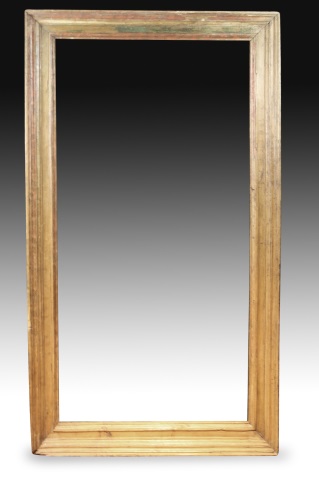
Frame. Carved wood. 17th century. It has faults. Rectangular frame made of carved wood that still retains some of its original polychromy. As was common in several European schools since the Renaissance (particularly the Italian, but also the Spanish, for example), it is decorated with a series of smooth moldings of varying widths, arranged to leave a plain band.
· Size: Ext 175x95 cm Int: 1.55x74 cms.
ANTIQUES
MISCELLANEUS;FRAMES
Ref.: Z6224
-
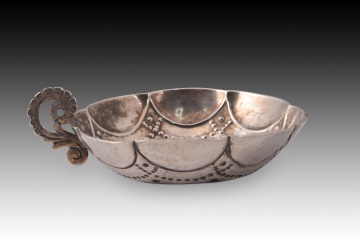
Quaking glass or wine-tasting glass. Silver. 18th century. One handle is missing. A vessel known as a catavinos or tembladera (as it has no foot) made of silver in its colour with a flat handle curved in the shape of an “S” decorated with simplified plant elements, and a line of mortise-shaped pieces (gallon-shaped shapes) on the edge enhanced by a smooth band. Towards the inside it has strings of pearls and dots, and a cross on the bottom. Bernegales and mortise-shaped pieces were frequent in Spanish silverware in the 17th century, usually being relegated to centres of somewhat less importance in the 18th century. Compare with pieces such as the silver bernegal from the last third of the 17th century in the Lázaro Galdiano Museum (perhaps from the Portuguese school; inventory 3916), or the one dated between 1640 and 1665 from the same museum (inventory 3910), or the one by José Jiménez de Illescas (inventory 3915, dated 1715-1725) in the same institution. Weight: 101 grams.
· Size: 12x10x4 cms.
ANTIQUES
MISCELLANEUS;SILVER
Ref.: ZE367
-
Silver spice rack. Stefano Olivero, Italy. Possibly 19th century. Silver spice rack raised on simple legs, located at the chamfered ends of the piece, decorated on the outside with garlands and other architectural elements of classicist influence in light relief. Weight: 198 grams.
· Size: 5,5 x 8,5 x 6,5 cm
ANTIQUES
MISCELLANEUS;SILVER
Ref.: ZF0006
-
Sold
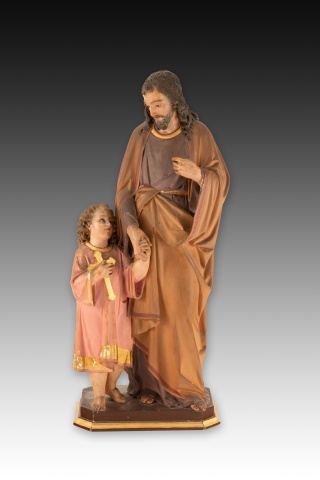
Saint Joseph with the Child Jesus. Polychrome wood. Spanish School, 19th century. Polychrome sculpture depicting Saint Joseph dressed in a tunic and cloak, standing, holding the Child Jesus by the hand, who appears wearing a short tunic and holding a Latin cross to his chest, following the iconography and composition common in the Spanish school of the 19th and 20th centuries (compare with examples from Olot, etc.).
· Size: 25x16x56 cms.
ANTIQUES
SCULPTURE
Ref.: ZF1400
-
Table clock. Bronze. 1990s, modeled after August Moreau. In working order. Table clock with a raised base and gilt-bronze legs following 19th-century models and a white dial with Roman numerals for the hours. It is topped with a bronze child figure modeled after Auguste Moureau (1834-1917), a French sculptor especially known for his delicate and naturalistic works, part of the Art Nouveau movement, a style of which he was a leading exponent. He made busts, figures, and small sculptures, and his designs were later adopted by many other bronze sculptors due to the artist's success and the quality of his pieces. Weight: 22 kg.
· Size: 35X22,5X64 cms
ANTIQUES
MISCELLANEUS;CLOCKS
Ref.: ZF1410
-
Peace-bearer. Bronze. 16th century. Bronze peace-holder with an asymmetrical “S” handle on the back, which features a slightly raised decoration on the front framed in an architectural composition decorated with elements of classical influence (a scallop shell at the top, plant elements in the upper area, columns with decorated shafts, architrave, base with semicircular arches, etc.), which has a heraldic shield in the centre of the lower area. Under a winged angel's head, the central theme of the peace-holder is presented: Lamentation over the body of the dead Christ, with the cross in the background, Mary with Christ, flanked by two figures. The heraldic shield is very similar to that of the House of Mendoza used by Íñigo López de Mendoza y de la Vega, 1st Marquis of Santillana, and progenitor and head of the Ducal House of Infantado (which also features it).
· Size: 7,5x4x12 cms.
ANTIQUES
MISCELLANEUS;OTHER OBJECTS
Ref.: ZF0541A
-
Monk's armchair. Walnut wood, leather. Spain, 16th century. Armchair with arms and high backrest of the type known as “friar's chair”, which has leather with studs on the seat and upper part of the backrest, very low chambranes joining the front legs with the back ones and middle chambranes or side rails (the front one carved with a relief of floral motifs flanking an empty heraldic shield in the round) joining the two front legs and the two back ones, and simple armrests, with the fluted fronts following architectural influences. The friar's chair, initially of Italian origin, became one of the most common pieces of Spanish furniture since its introduction in the 16th century, being characteristic of this and the 17th century and being recovered again in the historicist movement of the 19th century. Being such a deep-rooted tradition in Spain, this type of model was never stopped being created. Requires restoration.
· Size: 65,5x53x109 cms.
ANTIQUES
FURNITURE
Ref.: Z0706
-
Pair of frames. Wood, stucco. 19th century. Pair of rectangular frames made of carved and gilded wood decorated with a series of mouldings of different widths, some smooth and flat, others smooth and curved and two decorated with elements of classicist influence in light relief.
· Size: 42x5x34,5 cms . int 22,5x14,5 cms.
ANTIQUES
MISCELLANEUS;FRAMES
Ref.: Z2240
-
Three-part silver spice rack. 19th century. Spice rack made up of three bodies with lowered edges so that they fit together and join together in a semi-oval with a chamfer at the top, decorated with simple lines, as befits a 19th century work influenced by Neoclassicism. This type of spice rack is reminiscent in concept of the so-called “tower” examples, made in the Renaissance, but much more simplified. Weight: 150 grams.
· Size: 5x5x5,5 cms.
ANTIQUES
MISCELLANEUS;SILVER
Ref.: Z3035
-
Special Offer! - Off
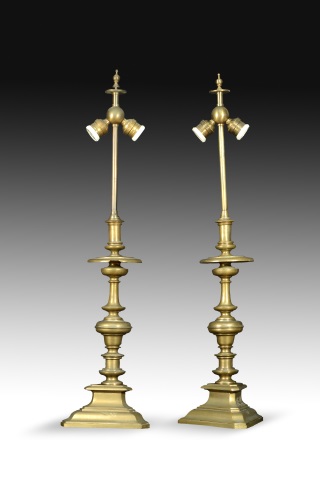
Pair of Dutch-style candlesticks. 18th century Bronze. Electrified like lamps. Pair of Dutch-style candlesticks converted into lamp bases. They feature a turned structure, typical of the refined Baroque style.
· Size: 55x55x79 cms.
ANTIQUES
MISCELLANEUS;OTHER OBJECTS
Ref.: Z6491
-
Pair of door knockers. Wrought iron. 16th century. Pair of door knockers made of wrought iron and composed of two nails with a ring to fix to the wood and a shape similar to a horseshoe attached to them. The latter, flat, is decorated with geometric engravings of lines and circles along its surface. Compare with pieces such as the 16th century Gothic knocker from the Lázaro Galdiano Museum (Madrid), Catalan pieces, etc.
· Size: 16x1,5x16 cms.
ANTIQUES
MISCELLANEUS;OTHER OBJECTS
Ref.: Z0208A
-
Lectern. Wrought iron. Baluster 17th century; rest 20th century. A wrought iron lectern with three twisted S-shaped legs with a disc in the centre, a balustraded base with different sections and a top with straight stripes. This central axis consists of different sections (solomonic and balustraded, joined by a piece of discs and other mouldings), and its lines are characteristic of ironwork of the period (compare, for example, with the Choir Grille of the Cathedral of Valladolid, currently in the Metropolitan Museum of New York, and note its differences). Weight: 22 kg.
· Size: 42x48x155 cms.
ANTIQUES
MISCELLANEUS;OTHER OBJECTS
Ref.: ZF0581
-
Spice rack. Silver. Spain, Cordoba, second half of the 18th century. With contrast marks. Silver spice rack in its colour with a truncated cone-shaped body, a sinuous lower edge resting on legs with scrolls and plant motifs, a semi-spherical bowl without divisions, a lid with a dome-shaped hinge and decorated with plant elements in high relief. The lid features a rose surrounded by a line of dots that create waves. The hallmarks place the piece's production in Córdoba, verified by Damián de Castro and by the hand of Juan Sánchez Soto (probably Cristóbal's son and brother), in the second half of the 18th century. Typologically, this is a spice rack belonging to a somewhat peculiar tradition or model, common in Córdoba and Madrid but also present in Gerona, Antequera, etc. Weight: 87 grams.
· Size: 7,5x6x5 cms
ANTIQUES
MISCELLANEUS;SILVER
Ref.: ZF0982
-
Spice rack. Silver. Cordoba, 18th century. With contrast marks. Silver spice rack in its colour with a truncated cone-shaped body, a sinuous lower edge resting on volute legs with osier and floral motifs, a hemispherical bowl, a lid with a dome-shaped hinge, and decorated with plant elements in high relief. The hallmarks it presents identify it as an 18th century Cordoban work, by the hand of Juan de Luque y Leyva or Leiva (1721-1779/80), who was an official marker of the city between 1772 and 1779/80. Typologically, it is a spice rack belonging to a somewhat peculiar tradition or model, frequent in Cordoba and Madrid but also present in Gerona, Antequera, etc. Weight: 68 grams.
· Size: 7x7x4,5 cms
ANTIQUES
MISCELLANEUS;SILVER
Ref.: ZF0983
-
Niche. Carved and polychrome wood. 16th century. Wall niche with a rectangular frontal recess topped by a gilded, veneered shape with two polychrome angel heads in the corners, and a dark polychrome space with gilded Classicist elements (candlesticks with grotesques, latticework, scrolls, etc.). The base features a polygonal finish on the front, with a red edge, like the rest of the piece. This type of pedestal was very common in private oratories in both civil (homes, etc.) and religious (convents, chapels, etc.) settings, for placing and highlighting small sculptures. Weight: 850 grams.
· Size: 18x9x47 cms.
ANTIQUES
SCULPTURE
Ref.: ZF1204
-
Sugar box. Silver in colour. Northern Europe (possibly Berlin), first half of the 19th century. With contrast marks. Rectangular box with chamfered corners resting on four claws with nails and featuring a lid with a projection towards the centre and a plaque with engraved initials of ownership. On the outside, it has a frieze of plant motifs above the keyhole. There is evidence of a sugar box in a private European collection with a hallmark similar to that of this piece (the initial A in a circle), being a neoclassical work from Berlin, the work of Gottlob Ludwig Howalt, and dated around 1820. This type of sugar bowls with closure were common in certain areas of northern Europe, taking on an appearance similar to that of this piece following the invasion of Napoleon Bonaparte, with which the French aesthetic models spread. Weight: 487 grams.
· Size: 16x12x10 cms.
ANTIQUES
MISCELLANEUS;SILVER
Ref.: ZF1319
-
Sold
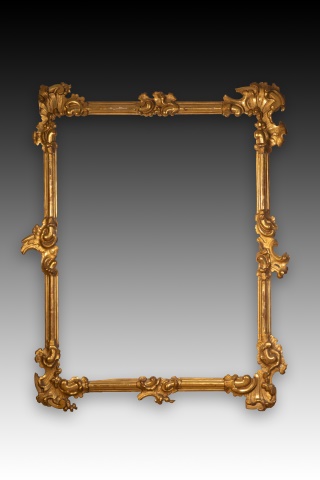
Rococo frame. Gilt wood. 18th century. Rectangular frame made of carved and gilded wood, decorated at the corners and centers of the sides with carvings depicting architectural elements, plants, and rocailles. The contrast between the plain moldings of the uncarved sections and the carvings, the absence of a crest, and the asymmetry present in the piece are striking. The latter was common in the early Rococo period, an artistic style born in France and developing primarily between 1730 and around 1760.
· Size: 100x3x121,5 cms. Int 76x99,5 cms
ANTIQUES
MISCELLANEUS;FRAMES
Ref.: ZF1336
-
Peace-bearer. Bronze. 16th century. A peace-bearer made of bronze with a flat handle curved on the back, with a relief decoration on the front organised in an architectural composition with a classical influence, common in the Renaissance. Below the columns on the sides there are two heraldic shields (without a bonnet, cords with tassels on three levels) with a Latin cross in the middle area; the centre shows a Birth of Christ under a domed cupola with winged angel heads in the corners; at the top and under a semicircular arch, there is the bust of Saint Dominic of the Causeway, facing forward, with an inscription in capital letters (“STO /DOMI”, “BENEDITUS SER”) flanked by two perched birds.
· Size: 10,5x4x16 cms.
ANTIQUES
MISCELLANEUS;OTHER OBJECTS
Ref.: ZF0543B
-
Plan, Fondazione Querini Stampalia. Framed drawing. SCARPA, Carlo (1906-1978), 1978. Signed and dated (bottom left), name in the center. Plan of Carlo Scarpa's intervention at the Fondazione Querini Stampalia, a cultural institution in Venice, Italy, founded in 1869 by Count Guiovanni Querini, the last descendant of the Querini Stampalia family. Carlo Scarpa designed the interior, exterior, and elements of the garden and ground-floor spaces of the historic building (Palazzo Querini Stampalia).
· Size: 47x4x65,5 cms
ANTIQUES
MISCELLANEUS;GRAPHIC WORK
Ref.: ZF135448
-
Sold
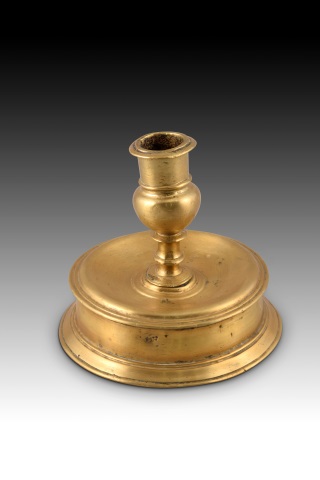
Reel candlestick. Bronze. 16th century. A candlestick of the type known as "reel" due to the shape of its base, made of bronze in its color. This type can already be found in Spanish Gothic pieces and has remained very common ever since. Over the following centuries, details such as the proportions of the base, its lines, and the top finial would be varied, adapting it to suit the taste of the moment.
· Size: 13.5x13.5x13 cms
ANTIQUES
MISCELLANEUS;OTHER OBJECTS
Ref.: ZE315
-
Pair of wrought iron fork locks. 17th century. Pair of forged iron fasteners of the so-called “fork” type due to their shape. This type of piece was used in furniture to secure tables, both dining tables and those in writing desks and bureaus, and for this reason it is a very common piece of forged iron. The spirals and the balustrade parts date both to the Baroque period.
· Size: 93x25 cms
ANTIQUES
MISCELLANEUS;OTHER OBJECTS
Ref.: Z6419B
-
Seven mustache makers with spoons. Silver, glass. England, 20th century. With contrast marks. Silver plated cutlery with glass elements inside and hallmarked: Henry Hobson & Sons., Birmingham, 1900; possibly E Druiff & Co., established 1919, Birmingham, possibly 1924; etc. They feature spoons, as is typical of this type, and are stylistically inspired by trends common in 19th century English silverware. Weight 530 grams.
· Size: 7,4x5x6 cms
ANTIQUES
MISCELLANEUS;SILVER
Ref.: ZF1373
-
Nightstand. Wood (mahogany and rosewood veneer), marble, bronze. 19th century. It has faults. Side table with four legs finished in metal fittings, a waist decorated with strips of lighter wood than the rest, highlighted with strips of gilded metal, and a circular top of light-colored stone with a cresting around the edge. It has two drawers with handles and two removable upholstered shelves. Stylistically, it is reminiscent of 19th-century French school designs.
· Size: 65,5x65,5x75 cns,
ANTIQUES
FURNITURE
Ref.: ZF1467